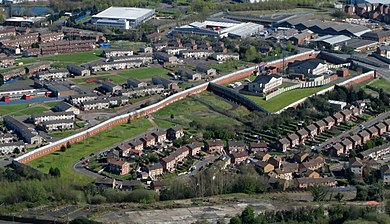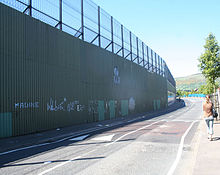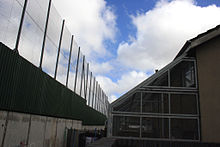| This article's lead section contains information that is not included elsewhere in the article. If the information is appropriate for the lead of the article, this information should also be included in the body of the article. (December 2019) (Learn how and when to remove this message) |




The peace lines or peace walls are a series of separation barriers in Northern Ireland that separate predominantly Irish republican or nationalist Catholic neighbourhoods from predominantly British loyalist or unionist Protestant neighbourhoods. They have been built at urban interface areas in Belfast and elsewhere.
The majority of peace walls are located in Belfast, but they also exist in other regions with more than 32 kilometres (20 miles) of walls in Northern Ireland.
History
Although temporary peace walls were built in Belfast in the 1920s (in Ballymacarett) and 1930s (in Sailortown), the first peace lines of "the Troubles" era were built in 1969, following the outbreak of civil unrest and the 1969 Northern Ireland riots. They were initially built as temporary structures, but due to their effectiveness they have become wider, longer, more numerous and more permanent. Originally few in number, they have multiplied over the years, from 18 in the early 1990s to at least 59 as of late 2017; in total they stretch over 34 kilometres (21 miles), with most located in Belfast. They have been increased in both height and number since the Good Friday Agreement of 1998. Three-quarters of Belfast's estimated 97 peace lines and related structures (such as gates and closed roads) are in the north and west of the city. These are also the poorer and more disadvantaged areas of Belfast. 67% of deaths during the sectarian violence occurred within 500 metres (550 yd) of one of these "interface structures".
The stated purpose of the peace lines is to minimise inter-communal violence between Catholics (most of whom are nationalists who self-identify as Irish) and Protestants (most of whom are unionists who self-identify as British).
The peace lines range in length from a few hundred metres (yards) to over 5 kilometres (3 mi). They may be made of iron, brick, steel or a combination of the three and are up to 8 metres (25 feet) high. Some have gates in them (sometimes staffed by police) that allow passage during daylight but are closed at night.
In recent years, they have become locations for tourism. Black taxis now take groups of tourists around Belfast's peace lines, trouble spots and famous murals.
The most prominent peace lines in the past few years separate the nationalist Falls Road and unionist Shankill Road areas of West Belfast; the nationalist Short Strand from the unionist Cluan Place areas of East Belfast, the unionist Corcrain Road and the nationalist Obins Drive in Portadown and the unionist Fountain Estate and nationalist Bishop Street area of Derry.
In 2008, a public discussion began about how and when the peace lines could be removed. Belfast City Council agreed to develop a strategy regarding the removal of peace walls on 1 September 2011. At the end of 2011, several local community initiatives resulted in the opening of a number of interface structures for a trial period. A study was released in 2012 indicating that 69% of residents believe that the peace walls are still necessary because of potential violence.
In January 2012, the International Fund for Ireland launched a Peace Walls funding programme to support local communities who want to work towards beginning to remove the peace walls. In May 2013, the Northern Ireland Executive committed to the removal of all peace lines by mutual consent by 2023.
In 2017, the Belfast Interface Project published a study entitled "Interface Barriers, Peacelines & Defensive Architecture" that identified 97 separate walls, barriers and interfaces in Belfast. A history of the development of these structures can be found at the Peacewall Archive.
In September 2017, the Northern Ireland Department of Justice published its Interface Programme, established to deliver the commitment made by the Northern Ireland Executive to remove all Interface structures by 2023 under the Together: Building a United Community Strategy.
In September 2019, a series of events were held in Belfast to mark the anniversary of 50 years of peace lines in the city. This included an international conference alongside other events to discuss the past and possible future of the peace lines.
See also
References
- "Cages around houses: Life at Belfast's peace wall". BBC News. Retrieved 16 April 2021.
- "Department of Justice Interface Programme | Department of Justice". Justice. 31 July 2017. Retrieved 1 November 2017.
- Donaghy, Brendan (ed.). "Launch of North Belfast Peace Walls Project". Mediation Digest. Archived from the original on 9 March 2016. Retrieved 4 July 2013.
- "Interfaces Map | Belfast Interface Project". www.belfastinterfaceproject.org. Retrieved 12 September 2018.
- Murtagh, Brendan (2017). "Urban alternatives and collaborative economics in Belfast's contested space". The social ecology of border landscapes. Grichting, Anna, Zebich-Knos, Michele (editors). London: Anthem Press. pp. 181–194. ISBN 9781783086719. OCLC 985108699.
- ^ Mell, Ian (2019). "Beyond the peace lines: Conceptualising representations of parks as inclusionary spaces in Belfast, Northern Ireland". The Town Planning Review. 90 (2): 195–218. doi:10.3828/tpr.2019.13. S2CID 150993274 – via Research Gate.
- Geoghegan, Peter (29 September 2015). "Will Belfast ever have a Berlin Wall moment and tear down its 'peace walls'?". The Guardian. Retrieved 13 April 2019.
- "Peace Walls". Northern Ireland Foundation. Archived from the original on 25 April 2019. Retrieved 13 April 2019.
- Macaulay, Tony (July 2008). "A Process for Removing Interface Barriers: A discussion paper proposing a five phase process for the removal of 'peace walls' in Northern Ireland" (PDF). Macaulay Associates. Retrieved 6 February 2010.
- "Belfast's peace walls may be set to tumble". The Irish Times. 3 September 2011. Archived from the original on 3 September 2011.
- "Belfast City Council agrees to act on peace walls". BBC News. 2 September 2011. Retrieved 2 May 2013.
- McAdam, Noel (18 January 2012). "£2m to tear down Northern Ireland peace walls". Belfast Telegraph. Retrieved 2 May 2013.
- "Peace Walls 'As Contentious As Ever'". Ulster Research. Retrieved 23 November 2012.
- "Northern Ireland: Cash Boost For Plan To Bring Down Peace Walls". HuffPost. 1 January 2012. Retrieved 2 May 2013.
- "Robinson and McGuinness want "peace walls" down within 10 years". The Irish Times. 10 May 2013. Retrieved 5 January 2014.
- "Interface Barriers, Peacelines and Defensive Architecture". Belfast Interface Project. Retrieved 18 June 2021.
- O'Leary, James (2 May 2019). "Peacewall Archive". Peacewall Archive. Retrieved 2 May 2019.
- "Department of Justice Interface Programme – Department of Justice". Justice. 31 July 2017. Retrieved 13 April 2019.
- "Together: Building a United Community (T:BUC)". The Executive Office. 23 August 2018. Retrieved 13 April 2019.
- "Peacewalls 50". Peacewall Archive. Retrieved 6 June 2020.
Further reading
- James O’Leary (28 October 2022) Belfast’s ‘peace walls’: How the politics and policy of 1969-1971 shaped the city’s contemporary ‘interface areas.’ Chapter 13 (pp 203-219) in The Routledge Handbook of Architecture, Urban Space and Politics, Vol I, ISBN 978-1-003-11246-4, doi:10.4324/9781003112464. Edited by Bobic and Haghighi, Routledge (Taylor & Francis Group, New York).
- Belfast Interface Project (2 June 2017). Interface Barriers, Peacelines and Defensive Architecture, ISBN 978-0-9548819-5-5, Belfast 2017. Retrieved 30 September 2017
- Paul Brown (4 February 2002). "Peace but no love as Northern Ireland divide grows ever wider". The Guardian. Retrieved 6 February 2010.
- Margrethe C. Lauber. "Belfast's Peacelines: An Analysis of Urban Borders, Design and Social Space in a Divided City". mspacenyc.com. Archived from the original on 20 August 2008. Retrieved 6 February 2010.
- Tony Macaulay (July 2008). "A discussion paper proposing a five phase process for the removal of 'peace walls' in Northern Ireland" (PDF). Macaulay Associates. Archived from the original (PDF) on 6 October 2011. Retrieved 6 February 2010.
- Shawn Pogatchnik (3 May 2008). "Despite peace, Belfast walls are growing in size and number". USA Today. Retrieved 6 February 2010.
External links
- Peacewall Archive (An archive of photos, maps, texts and links relating to Belfast's Peacelines)
- Belfast Interface Project Interfaces Map (An interactive map locating all Interface barriers in Northern Ireland, surveyed in 2017)
- NI Department of Justice Interface Programme (established to deliver the commitment made by the Northern Ireland Executive to remove all Interface structures by 2023)
- Peace Lines Archived 14 June 2011 at the Wayback Machine
- Ethnic Interface in North Belfast Archived 16 May 2011 at the Wayback Machine
- Forty years of peace lines (BBC News web page detailing the various peace lines across Northern Ireland as of mid-2009)